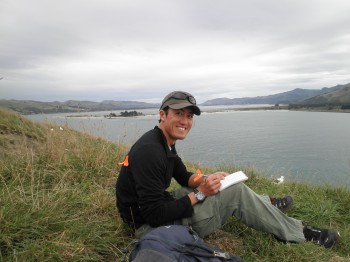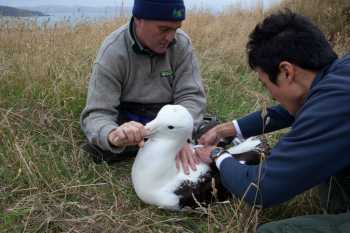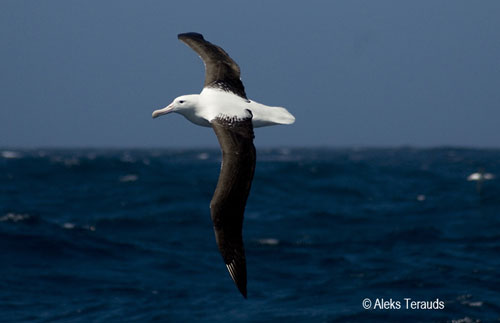Junichi Sugishita will be awarded a doctorate by the University of Otago at a graduation ceremony in May this year for his research on foraging by Northern Royal Albatrosses Diomedea sanfordi conducted at Taiaroa Head, New Zealand.

Junichi Sugishita at Taiaroa Head

Junichi (right) fits a tracker to a Northern Royal Albatross, helped by Lyndon Perriman
The abstract of his thesis follows:
“Monitoring and protection of seabirds that spend much of their lives at sea pose difficult conservation problems. In the case of pelagic seabirds, such as albatrosses, they can spend up to 95% of their lives at sea, and travel great distances. During these periods away from breeding colonies, the birds are exposed to a wide range of anthropogenic threats, including interactions with commercial fisheries and exposure to marine pollution. A detailed knowledge of seabird foraging ecology and behaviour at sea is therefore essential for conservation efforts.
Despite continuous, colony-based management of a small population of endangered northern royal albatross (Diomedea sanfordi) at Taiaroa Head/Pukekura, Dunedin, New Zealand, little is known about the relationship between their at-sea distribution, fisheries overlap, or chick provisioning. Recent risk assessments of fishery bycatch identified this species to be at-risk from fisheries within the New Zealand Exclusive Economic Zone (EEZ) during breeding. Understanding the nature and spatio-temporal extent of association between fisheries and foraging albatrosses is of important conservation concern. By incorporating information about at-sea distribution and behaviour with parental provisioning, ongoing albatross management at Taiaroa Head/Pukekura could be facilitated and complemented.
The central aim of this thesis is to gain quantitative insight into the relationship between parental foraging behaviour at sea and provisioning patterns at nests, especially with regard to fine-scale overlap with commercial fisheries, for northern royal albatross breeding at Taiaroa Head/Pukekura. First, I examined differences between breeders and pre-breeders (i.e. after returning to the colony but prior to the first breeding) in patterns of foraging distribution and activity, and in the relative association with commercial fisheries during the breeding season. Irrespective of breeding status, birds frequented waters over continental shelf break areas within 250 km of the colony. Breeders performed longer foraging trips and were more active in prey-searching behaviours at night than were pre-breeders. An overlap analysis indicated generally low rates of foraging overlap with fisheries, but breeders, compared to pre-breeders, exhibited higher propensity to forage in association with vessels, particularly squid trawlers. I then investigated the relative importance of intrinsic and extrinsic factors affecting parental provisioning behaviour during the chick-rearing period, as reflected in meal size, foraging trip duration, provisioning rate and colony attendance. Provisioning rate (g day-1) gradually increased with chick age, largely due to an increase in meal size rather than any increase in feeding frequency. Results indicate that provisioning behaviour was influenced by the differences in age- and sex-related chick food requirements, other factors related to parental foraging ability, as well as to wind conditions. Finally, I examined whether foraging in association with a fishing vessel is advantageous for chick provisioning in an attempt to better understand the ecological ramifications of seabird-fishery interactions. My results suggest that foraging in association with vessels does not confer an advantage for chick feeding, at least for my study birds during the study period.
Overall, the results of this thesis provide new insights into mechanisms shaping patterns of at-sea distribution and chick provisioning of northern royal albatross at Taiaroa Head/Pukekura, emphasising the importance of the localised area along the continental shelf break for this population. The results obtained here suggest that reproductive constraints play a key role in driving the increased foraging activity in breeders than in pre-breeders, which may lead to the higher tendency for breeders to forage in association with fishing vessels. By integrating seabird distribution, fishery association, and meal size, this thesis offers a new approach to the growing body of literature on the study of the complex nature of fine-scale overlap between seabirds and fisheries.”

Northern Royal Albatross at sea, photograph by Aleks Terauds
Click here to access a publication on Northern Royal Albatrosses by Dr Sugishita.
With thanks to Junichi Sugishita.
Reference:
Sugishita, J. 2016. Provisioning and foraging strategies of northern royal albatross (Diomedea sanfordi) at Taiaroa Head/Pukekura, and relationship with fisheries. PhD Thesis, Dunedin: University of Otago. 158 pp.
John Cooper, ACAP Information Officer, 02 March 2016

 English
English  Français
Français  Español
Español